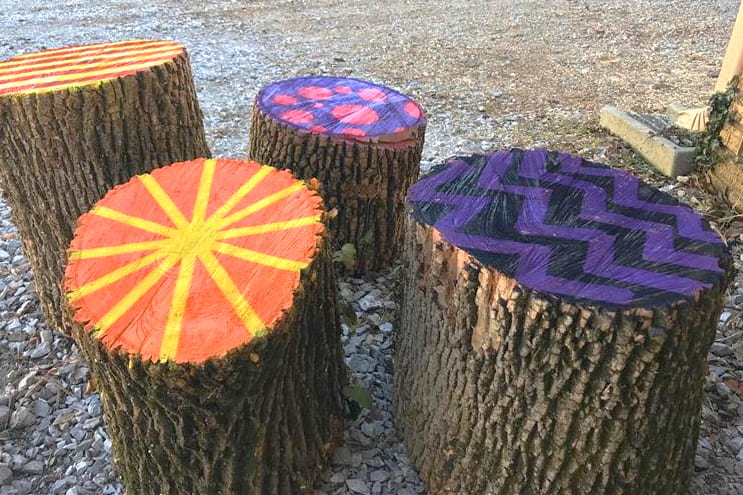Is Spring Fever hitting your art room hard as the year draws to a close? With the school days dwindling and the promise of summer around the corner, you and your students likely feel restless and anxious. It may be time to switch things up and take art class outside!
Moving your lessons out into nature is sure to be worth your while. Being outside reduces stress, anxiety, and depression while boosting self-esteem, mood, and confidence. Engaging in outdoor art education allows students to explore and practice critical thinking in a new environment. Students and teachers alike enjoy the refresh of making art outside!
Check out the Creating Art Outside Pack in PRO Learning for more benefits, tips, and an extensive review of everything you need to know to take artmaking outdoors.
Try one of these outdoor lessons to switch it up and get your students out into nature!
1. Shadow Drawings
Introduce students to contour line drawings. Then, pair students up and take them outside to practice drawing shadow lines. Students make interesting shapes with their hands, casting a shadow over a white piece of paper. One student makes the shapes while another draws. Then, switch! Use this as a stand-alone exercise or to introduce FLEX Curriculum’s “Contour Line Plants” lesson.

2. Yarn Bombing
Yarn bombing is a form of street art that covers public subjects with knitted or crocheted art. Students create circular weavings or basic structures with knitted or crocheted stitches. Take the work outside and string the creations together around the trunk of a tree. Spread the installations out so that bombed trees surround your school for maximum exposure!

3. Nature Weaving
Create large looms by nailing branches to trees or wood supports in a designated area. Prepare by warping the looms ahead of time with string, and invite students to collect materials for the weft. Students work together to weave all their items into a nature tapestry. Try the “Nature’s Stained Glass” lesson from FLEX Curriculum for a more straightforward, individual alternative.

4. Stump Painting
Share the essential role trees play in the environment and the many reasons for caring for them. Explain that it is sometimes necessary to cut trees down for various reasons, and cutting them down creates stumps. Celebrate everything trees give by turning their remains into stunning works of art!

5. Stained Glass Sidewalk
Discuss symmetry and patterns using cathedrals as references. Students develop a stained glass design. Take them outside to create their stained glass on a large scale with tape and sidewalk chalk. Wet the chalk to get a smoother consistency akin to painting. Go on a cathedral walk to take in the finished creations!

6. Tree Mobiles
Construct mobiles from durable materials like clay, wire, beads, and recycled items. Download the “Ceramic Ocean Food Chain Mobiles” lesson from FLEX Curriculum, or make similar ones with beads. When your students have fabricated their hanging masterpieces, spread them throughout the branches of nearby trees and watch them dance in the wind.

7. Fence Murals
Look at Christy Caravaglio’s fence murals and discuss the artist’s quilting and fiber inspiration. Discuss Caravaglio’s desire to brighten up neighborhoods with her work. Practice making designs in the classroom with colored pencils or pieces of yarn. Collaborate on a class design to brighten up a fence in the neighborhood.

Consider these logistical tips as you plan your favorite outdoor activity.
A new environment for your students is invigorating, but it can also be chaotic. Consider the tips below to set your students and lesson up for success.
- Scout your site ahead of time for safety and accessibility.
Consider allergens and safety hazards. Check out the path you will take to and from the site in advance, and get permission from your administration. Make sure all of your students can get to the area comfortably. - Communicate expectations before you leave the classroom.
Preparing your students for outdoor activities minimizes the issues you may face when you get outside. Cover rules for caring for the environment and keeping track of art supplies. Discuss any boundaries or signals students need to be mindful of. - Set clear boundaries to contain students in a visible area.
Keep students safe and accounted for by requiring them to stay within eyesight. Pick easy landmarks to describe the area to students, like a fence or the edge of the playground. - Determine a signal to round students up at the end of class.
Set an alert for when the activity is wrapping up. Use a whistle or a bell to get students’ attention. Do star jumps and have your students join until everyone is doing the exercise. - Have a backup plan, or two or three, for inclement weather.
You never know what might be coming your way. Make sure to plan a few extra indoor activities. For example, you can have students stitch their yarn bomb weavings together indoors or practice their stained glass patterns with colored chalk pastels.
Taking your artmaking into nature will eliminate your students’ spring fever in no time! Being outdoors reduces stress and builds confidence. Liven up the trees around your school with yarn bombing or tree mobiles, or practice patterns on the sidewalks and between tree branches. Consider what you need to plan and prep to make your outdoor art lesson safe and successful. Incorporate some of the ideas and tips above to make your art class a fresh place students look forward to each week.
What outdoor art project will you try with your students?
How do you prepare to take your artist outside?
Magazine articles and podcasts are opinions of professional education contributors and do not necessarily represent the position of the Art of Education University (AOEU) or its academic offerings. Contributors use terms in the way they are most often talked about in the scope of their educational experiences.





